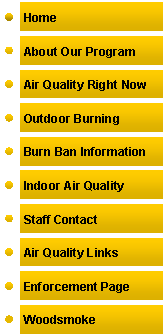



Find out if a burn ban is currently in effect for the Reservation.
Is Outdoor Burning Permitted?
► Yes, outdoor burning is permitted on the reservation, but general Tribal rules must be followed in order to ensure the safety of residents and their property. Federal air rules are also now in effect for the reservation, and are available on-line.
Are There Permits or Special Requirements?
► Yes, a permit is required for outdoor burning. Tulalip Ordinance 95 – Environmental Infractions, establishes a General Permit, which allows “any person on the Tulalip Reservation to light an outdoor fire, with the owner’s permission, on residential property, fueled by untreated wood or by lawn debris from that property; that is at all times directly supervised by an adult with a shovel and a charged water hose; that has no overhanging branches; that is maintained at least fifty (50) feet from any structure, vehicle or inflammables; and whose fire pile does not exceed four (4) feet in diameter and three (3) feet in height.
► In some cases, an Individual Permit is required. "An individual fire safety burn permit is required from the Control Officer for the lighting of any outdoor fire on the Tulalip Reservation which is not authorized by the general permit. The Control Officer may require information and impose conditions on the lighting of outdoor fires as necessary and appropriate to protect public safety. Individual burn permits shall be issued at no cost to qualified applicants."
Are Fires for Cultural/Spiritual Activities or Campfires Exempt?
► Yes, fires conducted for tribal cultural purposes are exempt and do not require any permit or approval. Campfires are also exempt, provided they are conducted within designated campground or recreation areas.
What Are The Safety Requirements for Outdoor Fires?
The Tribes’ Air Quality Protection Ordinance lists several safety requirements for outdoor fires. These include:
- The fire must consist of natural vegetation only resulting from maintenance of land immediately adjacent and in close proximity to a human dwelling.
- Burning may only be conducted on the lands on which the materials originated.
- The fire, of natural vegetation only, shall not contain rubber products, plastics, asphalt, garbage, dead animals, petroleum products, paints or similar materials that emit dense smoke or create offensive odors when burned.
- The fire pile must not be larger than four (4) feet in diameter and three (3) feet in height.
- A person capable of extinguishing the fire must be in attendance at all times and must fully extinguish the fire prior to leaving it.
- No fires are to be within 50 feet of a structure(s) or within 50 feet from any forest trees.
- Only one (1) pile may be burned at a time. Each pile must be fully extinguished before lighting another.
What is a burn ban and when do we need it?
► A Phase I Fire Safety or Phase II Burn Ban is a temporary ban on indoor and outdoor burning that is called when the fire hazard is high, or when weather conditions are especially still. These weather conditions, called inversions, trap pollution — mostly particles from wood smoke, but also emissions from cars and trucks — close to the ground.
► The Tulalip Tribes regulate air quality under their own sovereign authority, and also choose to voluntarily comply with burn bans called for Snohomish County. As of 2005, burn bans for the Tulalip Reservation may also be called by the U.S. Environmental Protection Agency.
What is allowed during a Phase I Fire Safety Burn Ban?
Tulalip Ordinance 95 – Environmental Infractions, Section .05.040 reads:
(b) Phase I Burn Ban. During a Phase I Fire Safety Burn Ban, no person may light any outdoor fire (including fireworks and other incendiary devices), provided, that recreational campfires may be lighted in approved metal or concrete enclosures in designated areas within campgrounds or on private land with the owner’s permission, and which:(c) Phase II Burn Ban. All outdoor fires (including fireworks and other incendiary devices) are prohibited.
- Are spread no larger than three (3) feet across,
- Burn seasoned firewood only,
- Are located in a clear spot free from any vegetation for at least 10 feet in a horizontal direction and having no overhanging branches, and
- Are attended at all times by an adult with immediate access to a shovel and a charged water hose.
Is Indoor Burning Okay During a Burn Ban?
► During a burn ban, both indoor and outdoor fires are prohibited. However, if your home’s primary source of heat comes from a woodstove or fireplace, then you may continue to burn during a ban.
Why is wood smoke a concern?
► Wood smoke from fireplaces and wood stoves contains tiny particles (PM2.5) that are a health threat to you and your neighbors. High levels of those particles are linked to an increase in asthma attacks, hospital admissions and premature deaths. Children, older people and people with lung and heart diseases are more at risk.
► Here is more information about indoor burning and the health effects of wood smoke.
|
To contact us:
Tulalip Tribes Dept. of Environment 7615 Totem Beach Road Tulalip, WA 98071 (360)651-4480 |
